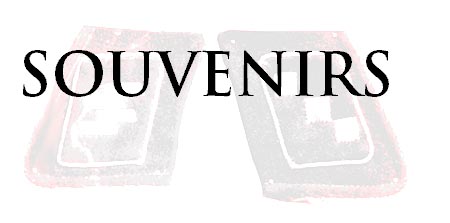
MARK BANDO'S WEBSITE
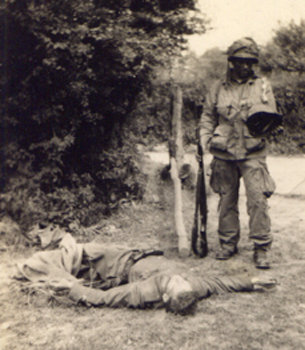 Souvenirs fall into two basic categories: friendly and enemy.
But many sub categories exist. Among both Allied and Axis souvenirs are weapons, headgear, uniforms, field equipment, ID papers/photos, documents and propaganda leaflets, insignia and medals. A sampling of souvenirs brought home by 101st Airborne soldiers in WW2 follows. All souvenirs depicted on these pages are from the webmaster's collection, unless otherwise noted.
Souvenirs fall into two basic categories: friendly and enemy.
But many sub categories exist. Among both Allied and Axis souvenirs are weapons, headgear, uniforms, field equipment, ID papers/photos, documents and propaganda leaflets, insignia and medals. A sampling of souvenirs brought home by 101st Airborne soldiers in WW2 follows. All souvenirs depicted on these pages are from the webmaster's collection, unless otherwise noted.
GERMAN SCHU MINE FOUND NEAR UTAH BEACH
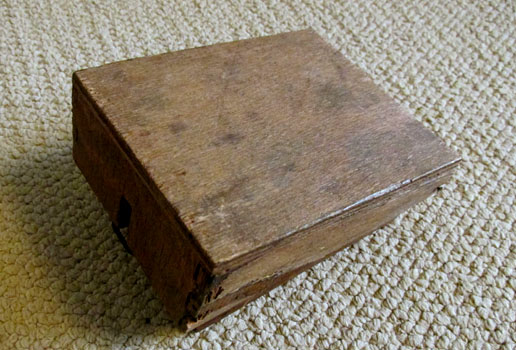 These diabolical devices were mostly constructed of wood, with a lid and a box, containing a spring loaded detonator and a small block of explosives. These were designed to blow-off the victim's foot above the ankle, thus putting him out of the war as surely as if he'd been killed. The Germans were following the doctrine of
Clausewitz, who wrote :"It is better to wound than to kill your enemy."
These diabolical devices were mostly constructed of wood, with a lid and a box, containing a spring loaded detonator and a small block of explosives. These were designed to blow-off the victim's foot above the ankle, thus putting him out of the war as surely as if he'd been killed. The Germans were following the doctrine of
Clausewitz, who wrote :"It is better to wound than to kill your enemy."
These diabolical gadgets were made of wood for the purpose of defeating mine detectors, however, in the field just behind Utah Beach, where this specimen had been hastily buried, the grass had died at the spot where each mine had been buried, making it easy to avoid stepping on them. It also made recovery and deactivation easy. Some German mines were equipped with anti-tampering devices, making it deadly to handle them. However Pfc Donald E. Zahn of H/506th PIR, dug this one out and de-activated it himself, which he says was no big deal. He sent it home as a souvenir and the webmaster asked a local ordnance collector to add an inert block of wood, to simulate the explosive charge (the photo below gives you an idea of how large it was), and to replace the triggering mechanism. A foot pressing down on the lid caused a blocking pin to move, allowing the spring-loaded firing pin to strike the charge.
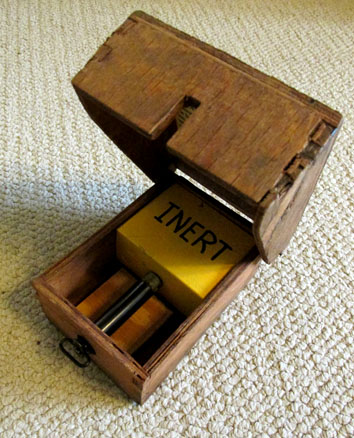
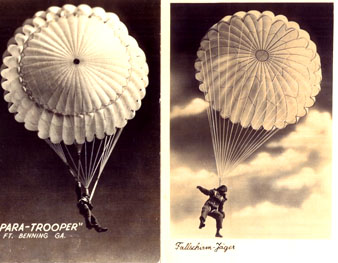 Opposing sides in WW2 produced almost identical postcards, as souvenirs for American (l) and German (r) parachutists to mail home to their families and friends. The U.S. example comes from Captain Fred Hancock of C/502. The German version was liberated by Captain Joe Pangerl of IPW Team#1, 502 PIR. Note the similarity of photos and even captions, with a hyphen between "Para-trooper" and "Fallschirm-Jager." Whether one of these was modeled after a captured enemy example is unknown, but the similarities are remarkable.
Opposing sides in WW2 produced almost identical postcards, as souvenirs for American (l) and German (r) parachutists to mail home to their families and friends. The U.S. example comes from Captain Fred Hancock of C/502. The German version was liberated by Captain Joe Pangerl of IPW Team#1, 502 PIR. Note the similarity of photos and even captions, with a hyphen between "Para-trooper" and "Fallschirm-Jager." Whether one of these was modeled after a captured enemy example is unknown, but the similarities are remarkable.
Customized Lighter
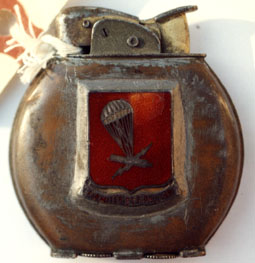 This typical 40s era cigarette lighter was customized by addition of a 377th PFAB unit crest. It comes from the effects of S/Sgt Ed Benecke, Battery 'A', 377th PFAB.
This typical 40s era cigarette lighter was customized by addition of a 377th PFAB unit crest. It comes from the effects of S/Sgt Ed Benecke, Battery 'A', 377th PFAB.
Short Snorter
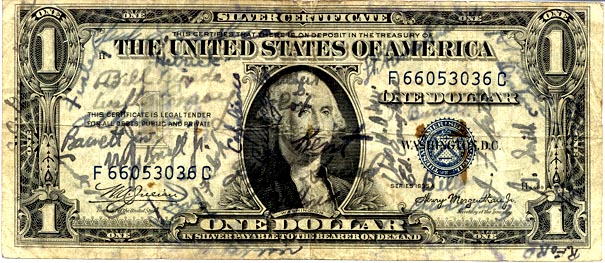 The tradition of the Short Snorter was started by British troops who collected paper currency from all the countries they had served in, and taped them together like an accordian. At the pub, each man unfurled his collection and the one with the shortest collection had to buy drinks for all his buddies. In the U.S. Paratroops, one note,
passed around to be signed by buddies was kept as a souvenir. The one dollar silver certificate depicted above and below was kept by Nick Denovchik of A/501 PIR and is signed by such men as
Bill Spivey (POW-lost eye to a German potato masher at St Georges du Bohon on D-Day), Lt Sumpter Blackmon (EXO), Michael Kovalik, T/5 Marty Knafl (POW on D-Day), Lt Edley Craighill(KIA), John Fekete, Lt Bert Waggoner, Medic Francis Harbaugh (DSC with 508th at Hill 30), Frank Seymour (mail clerk-later 1st Sgt), Joe Taylor (PW at St Georges on D-Day), Lt Paul Gibson, and
Joseph Forese (KIA).
The tradition of the Short Snorter was started by British troops who collected paper currency from all the countries they had served in, and taped them together like an accordian. At the pub, each man unfurled his collection and the one with the shortest collection had to buy drinks for all his buddies. In the U.S. Paratroops, one note,
passed around to be signed by buddies was kept as a souvenir. The one dollar silver certificate depicted above and below was kept by Nick Denovchik of A/501 PIR and is signed by such men as
Bill Spivey (POW-lost eye to a German potato masher at St Georges du Bohon on D-Day), Lt Sumpter Blackmon (EXO), Michael Kovalik, T/5 Marty Knafl (POW on D-Day), Lt Edley Craighill(KIA), John Fekete, Lt Bert Waggoner, Medic Francis Harbaugh (DSC with 508th at Hill 30), Frank Seymour (mail clerk-later 1st Sgt), Joe Taylor (PW at St Georges on D-Day), Lt Paul Gibson, and
Joseph Forese (KIA).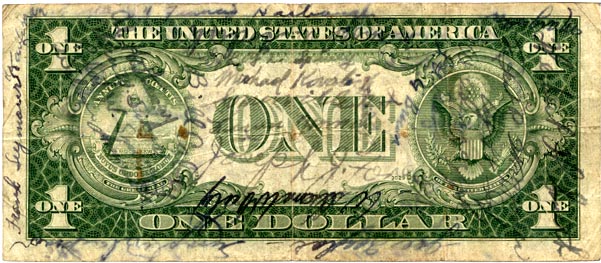
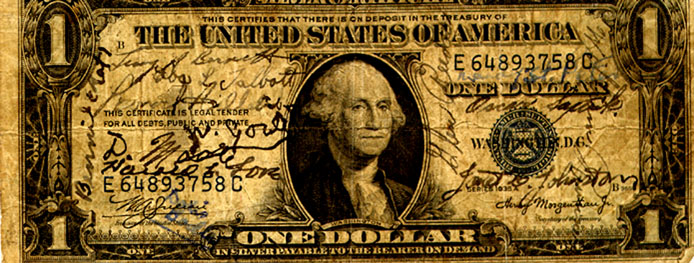 Here's another example-this one from B/506th. Note Glenn Reeder's signature. He held the divisional record for most kills in one battle-over 80 in a night battle in an orchard near Opheusden, Holland early October, 1944. This specimen was preserved by Harry Hendersin.
Here's another example-this one from B/506th. Note Glenn Reeder's signature. He held the divisional record for most kills in one battle-over 80 in a night battle in an orchard near Opheusden, Holland early October, 1944. This specimen was preserved by Harry Hendersin.
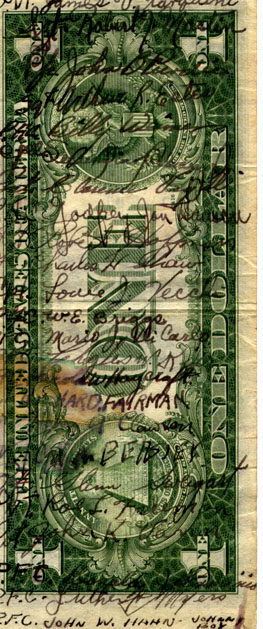 Here's a Short Snorter added to the webmaster's collection in June of 2004. It is signed by members of 1st platoon H/506th(The Forty Thieves), before Normandy.
Here's a Short Snorter added to the webmaster's collection in June of 2004. It is signed by members of 1st platoon H/506th(The Forty Thieves), before Normandy.
Such notables as Louis Vecchi, Mario 'Hank' DiCarlo, Robert J. Martin, and James Tarquini signed this. Out of the 24 guys who signed it, Godfrey 'Jon' Hanson, Glen Sweigert, Sgt Harry Clawson (SS), and John 'Johnn Boy' Hahn, were later killed in action. Bill Weimer and Sgt Arthur Estes became POWs in Normandy and for the duration.
This comes courtesy of Donald E. Zahn (DSC).
A More Traditional Snorter
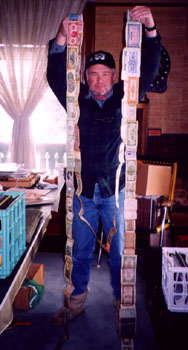 The late Joe Beyrle of I/506th was a great accumulator or 101st and other assorted WW2 memorabilia. In early 2005, his son, Joe B II, has taken on the task of sorting through his father's treasure trove. Among his discoveries was the Brit type short snorter depicted above. This is many feet long and like the original ones, consists of bills from different nations, all stapled together. The staples have started to rust so a command decision was made to separate them and place them in a western Michigan museum.
The late Joe Beyrle of I/506th was a great accumulator or 101st and other assorted WW2 memorabilia. In early 2005, his son, Joe B II, has taken on the task of sorting through his father's treasure trove. Among his discoveries was the Brit type short snorter depicted above. This is many feet long and like the original ones, consists of bills from different nations, all stapled together. The staples have started to rust so a command decision was made to separate them and place them in a western Michigan museum.
Enemy Equipment Captured in Mortal Combat
-NORMANDY-
Soldbuch
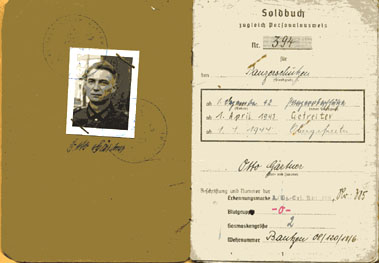
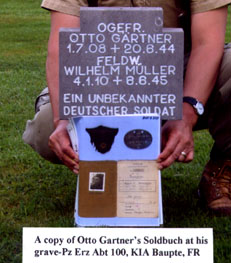 A Soldbuch or paybook, resembling a passport with the owner's photo stapled or riveted inside the front cover, was carried by every German soldier. This was more of an identity book than a pay record and includes all info on the soldier. Where and when he was inducted, place and date of birth, color of eyes and hair, height, weight, name of parents and spouse, equipment issued, inoculations, hospitalizations, dental work, decorations awarded, and every unit the owner ever belonged to. Naturally these books were a wealth of information for Allied intelligence personnel, but they were supposed to remain with the body if a soldier fell in battle, for identification purposes. Sometimes, this didn't happen, as the books were turned-in to IPW and later burned, or were sent home as souvenirs by individual GIs.
A Soldbuch or paybook, resembling a passport with the owner's photo stapled or riveted inside the front cover, was carried by every German soldier. This was more of an identity book than a pay record and includes all info on the soldier. Where and when he was inducted, place and date of birth, color of eyes and hair, height, weight, name of parents and spouse, equipment issued, inoculations, hospitalizations, dental work, decorations awarded, and every unit the owner ever belonged to. Naturally these books were a wealth of information for Allied intelligence personnel, but they were supposed to remain with the body if a soldier fell in battle, for identification purposes. Sometimes, this didn't happen, as the books were turned-in to IPW and later burned, or were sent home as souvenirs by individual GIs.
The Soldbuch above belonged to Cpl Otto Gartner, a 36 year old member of Panzer Training Bn 100. He was born 1 July, 1908, and was KIA at Baupte, France in June of 1944.
Panzer Bn 100 was equipped with captured French Renault tanks, and
Gartner was killed by a gammon grenade as his tank charged along the main street of Baupte (see 'Vanguard of the Crusade' for an account of this action by Carl Beck of H/501). At the time, Baupte was being contested by 2/508 PIR, with help from Robert Johnson and Carl Beck of H/501. This Soldbuch has been in the webmaster's collection since 1982, courtesy Carl Beck.
German Army M40 Style Combat Helmet
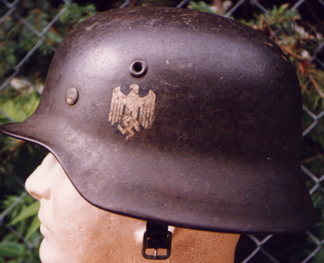 Captain Fred Hancock, Company Commander of C/502, liberated this helmet in Normandy. The original owner was probably a member of the 243rd Infantry Division. Note that the air hole is intergrally-molded into helmet shell, unlike the M35 helmet pictured on page 4 of Souvenirs.
Captain Fred Hancock, Company Commander of C/502, liberated this helmet in Normandy. The original owner was probably a member of the 243rd Infantry Division. Note that the air hole is intergrally-molded into helmet shell, unlike the M35 helmet pictured on page 4 of Souvenirs.
Typical of M40 helmets this example also has only one decal, the Wehrmacht Adler. The paint and decal on this helmet are well-worn and blended so well, that the decal looks like an integral part of the paint.
Soldbuch from Parachute Regiment 6, Normandy
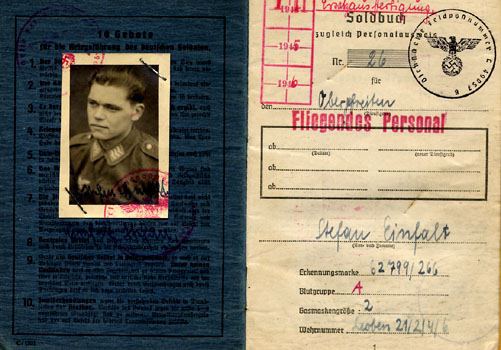 Obergefreiter (senior corporal Stephan Einfalt was born 5 November, 1921. He was KIA on 7 June, 1944, at Peneme, France (Hell's Corners, near la Barquette). This ID book was removed from Einfalt's body after the 1st Bn, 6th Para Regiment was destroyed in a battle with elements of the 501 PIR. Harold Paulson of C/501 brought the book home in his musette bag. Entries in the book indicate Einfalt belonged to 1st Kompanie of Para Rgt 6.
Obergefreiter (senior corporal Stephan Einfalt was born 5 November, 1921. He was KIA on 7 June, 1944, at Peneme, France (Hell's Corners, near la Barquette). This ID book was removed from Einfalt's body after the 1st Bn, 6th Para Regiment was destroyed in a battle with elements of the 501 PIR. Harold Paulson of C/501 brought the book home in his musette bag. Entries in the book indicate Einfalt belonged to 1st Kompanie of Para Rgt 6.
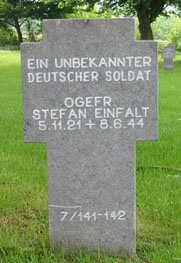 Stephen Einfalt is buried in the German military cemetery at Orglandes, France in block 7, row 5, grave 142.
Stephen Einfalt is buried in the German military cemetery at Orglandes, France in block 7, row 5, grave 142.
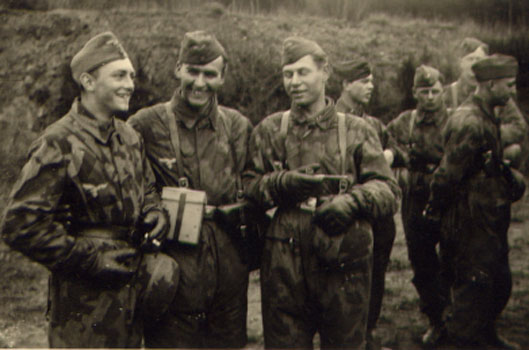 Donald Zahn of H/506th liberated a small batch of very nice photos from FJ Rgt 6 west of Carentan in mid June of 1944. The group shot above shows some FJR 6 members in 1944, wearing camouflaged (splinter pattern) type 3 jump smocks and leather gauntlets.
Donald Zahn of H/506th liberated a small batch of very nice photos from FJ Rgt 6 west of Carentan in mid June of 1944. The group shot above shows some FJR 6 members in 1944, wearing camouflaged (splinter pattern) type 3 jump smocks and leather gauntlets.
photo c/o Donald E. Zahn
Mark Bando's Website
Personal Ties
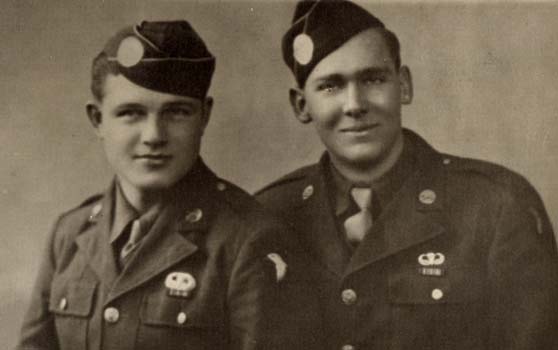 Above in an English photo studio, Barney Becker (l) and Richard Brinkley (r), both of the 81mm mortar platoon of HQ Co., 1st Bn. 506th PIR. Becker sustained a serious head wound near Opheusden, Holland later in 1944.-photo c/o R. Brinkley
Above in an English photo studio, Barney Becker (l) and Richard Brinkley (r), both of the 81mm mortar platoon of HQ Co., 1st Bn. 506th PIR. Becker sustained a serious head wound near Opheusden, Holland later in 1944.-photo c/o R. Brinkley
Taking the life of an enemy at point blank range, when the enemy was trying to take your life, can form a mysterious bond between the killer and the killed.
On 7 June, 1944, as elements of 1st Bn 506th PIR fought their way south along the D913 road, towards Carentan, they encountered some German troops in fields, alongside that road. Richard Brinkley and Barney Becker of HQ Co. 1st Bn 506th, entered a field less than 1/2 mile north of Dead Man's Corner and found many cases of German ammunition and rations, stacked in a storage space that was cut into the side of a hill. Becker saw three Germans run into the storage area; he chased them in amongst the crates and killed them with the B.A.R.which he had recovered from a glider on D-day.
Thinking the threat was past, Brinkley casually walked into the area where the ammo boxes were stacked. Then he heard several shots and felt slugs pass close to his face. He realized that someone was shooting at him, from relatively close-range, (from behind the ammo crates), so he took cover. When the shooter emerged from concealment to shoot again, Brink saw him aiming a Luger pistol. Brink returned fire from his Thompson SMG and killed a German Parachutist officer. The first thing Brink did, upon examining the body of his newly-fallen victim, was to grab his pistol, which turned out to be a byf41 'Black Widow' Luger. Brink also wanted the officer's cap, which had a high peak and a jaunty saddle-like shape. But, having no place to carry it, he crushed it into a little ball, and stuffed the cap into the cargo pocket of his M42 jump trousers, which broke much of the stitching in the cap.
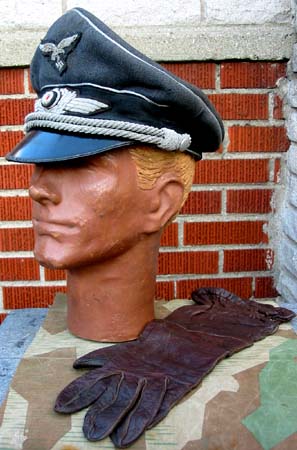 This shows the cap taken from the fallen Luftwaffe Para officer as well as one of his gauntlets-Brink had the pair, but he lost one side after the war. The gauntlet however, verifies that the victim was a parachutist. The cap has hand-embroidered aluminum bullion insignia and the thick type officer cap cords.
This shows the cap taken from the fallen Luftwaffe Para officer as well as one of his gauntlets-Brink had the pair, but he lost one side after the war. The gauntlet however, verifies that the victim was a parachutist. The cap has hand-embroidered aluminum bullion insignia and the thick type officer cap cords.
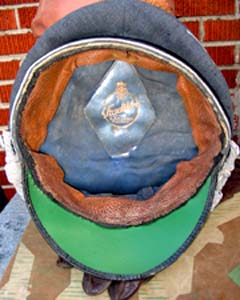 This shows the well worn interior of the cap-the maker's name incorporates the word 'Tradition', which has the same meaning in German and English.
This shows the well worn interior of the cap-the maker's name incorporates the word 'Tradition', which has the same meaning in German and English.
Brinkley took some time to remove items from the fallen German Luftwaffe officer. He also took his ring, his wristwatch, a pair of forearm-length leather gauntlets, and the hardshell holster for the Luger.
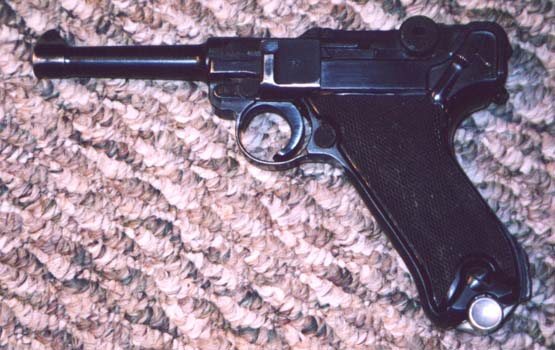 Here is a view of the pistol taken from the fallen Para officer-it has the black plastic grips typical of a Byf41 Luger. This was added to the webmaster's collection in March of 2006.
Here is a view of the pistol taken from the fallen Para officer-it has the black plastic grips typical of a Byf41 Luger. This was added to the webmaster's collection in March of 2006.
That night, the 506th withdrew and slept near Beaumont, France. Returning to the same field the next day, Brink discovered that the Germans had removed the bodies of their fallen comrades, as well as all the ammunition boxes. Ration boxes were still there, containing blue metal cans with meat inside. Brink ate some, although Becker snubbed the stuff, dismissing it as probable 'horsemeat'. Brink was so hungry he says the stuff tasted good.
In the same field, Brink found a discarded 1st model snail drum magazine, for an artillery model Luger, with a missing rotation bar, which he also kept.
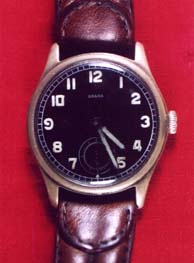
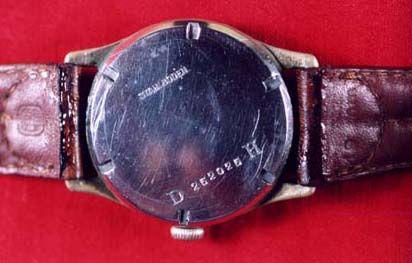 Here are front and reverse views of the wristwatch which Brink took from the same fallen officer.
Here are front and reverse views of the wristwatch which Brink took from the same fallen officer.
It is a German military issue watch and Brink wore it for several years after WW2, until it stopped running. It was repaired recently and once again keeps time. I have seen other cases in which a soldier kept only souvenirs from one particular fallen enemy, whose death had a special significance in the mind of that individual.
This example of Brink is rather unique, because he wore the dead man's ring and he used the wristwatch for years after the war. But despite searching his house, Brink has been unable to locate the ring. There was an initial on the ring, which could aid in establishing the identity of that German officer. I'm hoping that in the near future, veterans of the 6th Para Regt, who attend the annual FJ reunion in Germany, will be able to identify the name of this fallen officer.
Souvenirs From Hells Corners
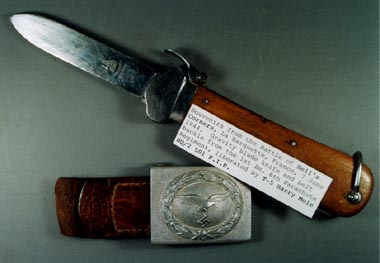 The German paratrooper's gravity knife and belt buckle above were liberated from a member of the 1st Bn Parachute Regiment 6 at la Barquette, France. This was the same battle mentioned above, on 7 June, 1944. c/o Harry Mole 2/501 commo. The knife was carried in a special leg pocket on the right leg of the field gray FJ trousers as shown on the corpse below (snap on pocket flap visible). This fallschirmjager was killed in Cole's bayonet charge and the flap of his leg pocket for his gravity knife can be clearly seen, as well as his FJ-issued jump boots. Mauser stripper clips, each holding 5 rounds of 8mm ammo are visisble as well as the stock and bolt of his Karabiner 98k.
The German paratrooper's gravity knife and belt buckle above were liberated from a member of the 1st Bn Parachute Regiment 6 at la Barquette, France. This was the same battle mentioned above, on 7 June, 1944. c/o Harry Mole 2/501 commo. The knife was carried in a special leg pocket on the right leg of the field gray FJ trousers as shown on the corpse below (snap on pocket flap visible). This fallschirmjager was killed in Cole's bayonet charge and the flap of his leg pocket for his gravity knife can be clearly seen, as well as his FJ-issued jump boots. Mauser stripper clips, each holding 5 rounds of 8mm ammo are visisble as well as the stock and bolt of his Karabiner 98k. 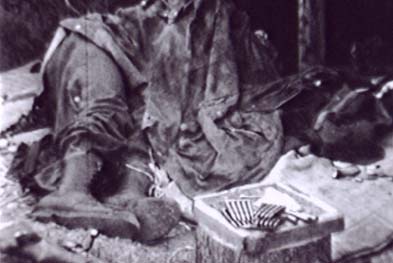
More German F.J. Equipment
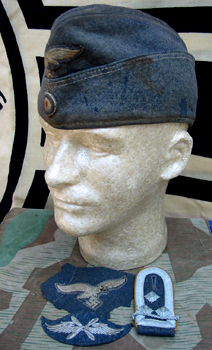 The Luftwaffe overseas cap as shown above was probably the most common item of Nazi military headgear made. But the one illustrated was liberated in Normandy by Captain George Lage 2/502 surgeon. This cap has a unique character, in that it is extremely sun-faded and well-worn. It also bears a bright red smear of blood on the left side. The senior non com shoulder board with twisted cord indicating the owner was awaiting promotion to an officer rank, was in the same grouping of effects. It might have belonged to the same Sgt as the flying eagle cut from the chest of a flieger blouse and the specialist sleeve patch for flying troops.
The Luftwaffe overseas cap as shown above was probably the most common item of Nazi military headgear made. But the one illustrated was liberated in Normandy by Captain George Lage 2/502 surgeon. This cap has a unique character, in that it is extremely sun-faded and well-worn. It also bears a bright red smear of blood on the left side. The senior non com shoulder board with twisted cord indicating the owner was awaiting promotion to an officer rank, was in the same grouping of effects. It might have belonged to the same Sgt as the flying eagle cut from the chest of a flieger blouse and the specialist sleeve patch for flying troops.
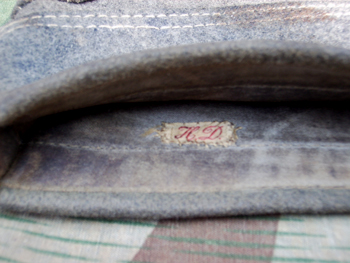 Inside the same cap is a small tag with red letters, sewn into the lining, giving the initals of the original owner.
Inside the same cap is a small tag with red letters, sewn into the lining, giving the initals of the original owner.
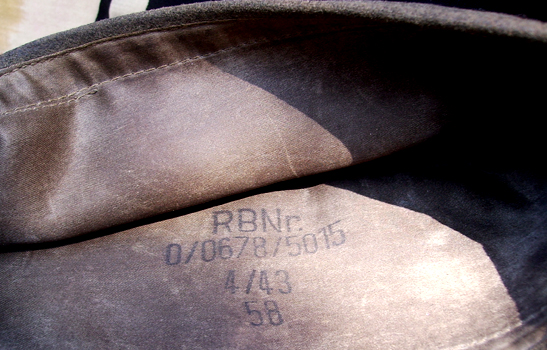 Another view inside the same cap-I've owned and examined many of these but have never seen a nicer RB Number. The cap was only a little more than a year old when the owner was struck down in combat-he obviously wore the cap heavily in the short time that he owned it.
Another view inside the same cap-I've owned and examined many of these but have never seen a nicer RB Number. The cap was only a little more than a year old when the owner was struck down in combat-he obviously wore the cap heavily in the short time that he owned it.
Luftwaffe M43 Forage Cap with Short Bill
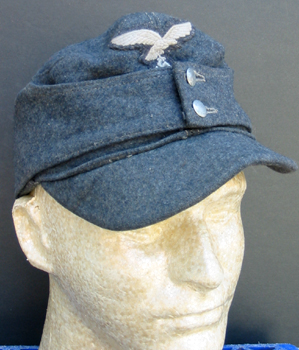
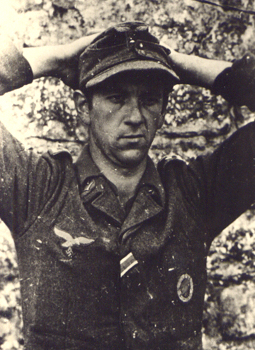 Pfc Don Zahn of H/506th PIR liberated the cap shown above left from the 6th Para Rgt in Normandy. This cap is unusual for a Luftwaffe M43 cap, because of it's short bill, closer in appearance to the German Bergmutze (mountain cap). The 6th Para P.O.W. pictured at right was photographed in Normandy by Al Krochka. His cap also appears to have a short visor. The cloth insignia of his 'Fallschirmjager Abzeichen' can be seen on his flieger blouse.
Pfc Don Zahn of H/506th PIR liberated the cap shown above left from the 6th Para Rgt in Normandy. This cap is unusual for a Luftwaffe M43 cap, because of it's short bill, closer in appearance to the German Bergmutze (mountain cap). The 6th Para P.O.W. pictured at right was photographed in Normandy by Al Krochka. His cap also appears to have a short visor. The cloth insignia of his 'Fallschirmjager Abzeichen' can be seen on his flieger blouse.
Zahn's souvenir bears a round, 3-dimensional national colors rosette, rather than the oft-seen flat, diamond-shaped, machine woven version of the red/white/black concentric circles. The usual grey satin lining bears no size nor maker markings.
Cloth Fallschirmjager Badges from Normandy
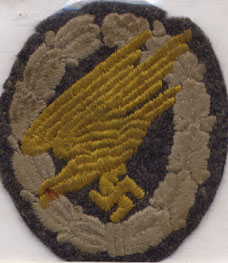
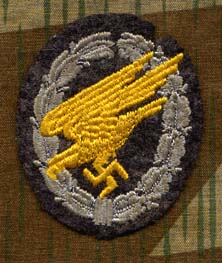
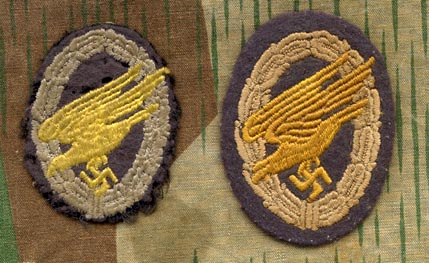 Cloth parachutist qualification badges as shown above, were worn by German paratroopers on the lower left chest of their fliegerblouses,
The 4 examples shown above were liberated from members of the 6th Parachute Regiment, who became victims of the fighting near Carentan, France, in June of 1944.
Cloth parachutist qualification badges as shown above, were worn by German paratroopers on the lower left chest of their fliegerblouses,
The 4 examples shown above were liberated from members of the 6th Parachute Regiment, who became victims of the fighting near Carentan, France, in June of 1944.
The example at top left, was liberated by Phil Hooper of B/327th GIR. The example at top right was taken by Adam Slusher of C/326th Airborne Engineer Bn.
Sgt Ed Benecke of A/377th salvaged the rather shrunken specimen at lower left. The one at bottom right, was taken by Frank Tiedeman of F/502. All 4 specimens were evidently manufactured by different companies, and they show a distinct difference in design style, thread colors, and overall size.
Although these were generally worn in the field, in lieu of the metal version of the award, examples of the metal badge were also taken in combat. I have one which Bob Granche of C/326th AEB ripped from the chest of a prisoner at St Come du Mont on 8 June, 1944. The nicest metal FJ badge I've ever seen was taken from a member of 1st Bn 6th Para at Vierville, on 7 June, 1944, by LTC Strayer's radio operator, Bill Maslowski.
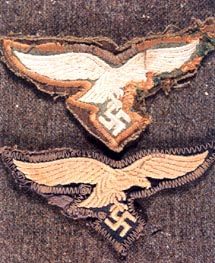 The 2 chest insignia shown above, were both cut from Luftwaffe paratrooper jump smocks, by Lt Charles Bowser of Company 'C', 501 PIR. Both still have a bit of smock material attached to the backside, and both are sewn in the zigzag stitching peculiar to Luftwaffe clothing.
The 2 chest insignia shown above, were both cut from Luftwaffe paratrooper jump smocks, by Lt Charles Bowser of Company 'C', 501 PIR. Both still have a bit of smock material attached to the backside, and both are sewn in the zigzag stitching peculiar to Luftwaffe clothing.
MARK BANDO'S WEBSITE
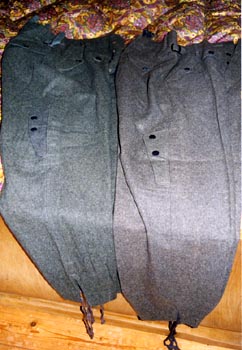 Above are two original pairs of FJ trousers. The pocket for the gravity knife is visible on the right leg of each pair. Note also the varied shades of field grey color.
Above are two original pairs of FJ trousers. The pocket for the gravity knife is visible on the right leg of each pair. Note also the varied shades of field grey color.
German Paratrooper's Helmet Liberated in France
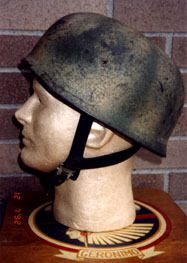
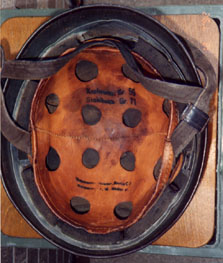 This helmet was taken from the battlefield at Peneme, France on 7 June, 1944, following the decimation of 1st Bn, FJ Rgt 6, by elements of the 501 PIR. It exhibits the most common camo paint scheme used by German paratroopers in Normandy in June-July, 1944, and is the color scheme that should have been used on FJ helmets in the 'Band of Brothers' miniseries. This specimen was liberated by Lt G.W. Sefton, 2/501 PIR and is currently the pride of the webmaster's collection.
This helmet was taken from the battlefield at Peneme, France on 7 June, 1944, following the decimation of 1st Bn, FJ Rgt 6, by elements of the 501 PIR. It exhibits the most common camo paint scheme used by German paratroopers in Normandy in June-July, 1944, and is the color scheme that should have been used on FJ helmets in the 'Band of Brothers' miniseries. This specimen was liberated by Lt G.W. Sefton, 2/501 PIR and is currently the pride of the webmaster's collection.
Captain Hancock's Cabbage Patch Helmet
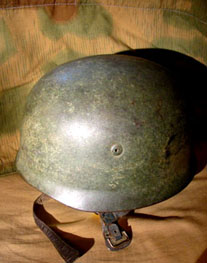 This extremely small (size 54 cm.) FJ helmet bears the classic tan/green camo paint scheme commonly found on Normandy helmets. Captain Fred Hancock's Company 'C' of the 502 PIR played a crucial role in clearing Fallschirmjagers from the cabbage patch at the north edge of Carentan, France, on Sunday, 11 June 1944. The area is now known as 'Hancock Field'. Fred picked up this helmet from that battlefield,after the fighting. We surmise that the original owner was a member of 3rd battalion, Parachute Regiment 6. The flying eagle decal of the Luftwaffe is still visible under the veneer of camo paint, on the left side of the helmet.
This extremely small (size 54 cm.) FJ helmet bears the classic tan/green camo paint scheme commonly found on Normandy helmets. Captain Fred Hancock's Company 'C' of the 502 PIR played a crucial role in clearing Fallschirmjagers from the cabbage patch at the north edge of Carentan, France, on Sunday, 11 June 1944. The area is now known as 'Hancock Field'. Fred picked up this helmet from that battlefield,after the fighting. We surmise that the original owner was a member of 3rd battalion, Parachute Regiment 6. The flying eagle decal of the Luftwaffe is still visible under the veneer of camo paint, on the left side of the helmet.
Another FJ Helmet
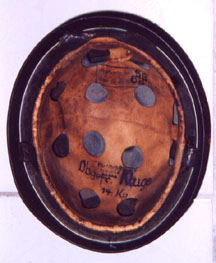 Captain Joe Pangerl was head of IPW Team #1, attached to the 502nd PIR. He brought this FJ helmet home, but does not remember if he acquired it in Normandy or Holland. It bears the same camo paint scheme as Sefton's helmet, and written on the leather of the liner is the name and rank:
Captain Joe Pangerl was head of IPW Team #1, attached to the 502nd PIR. He brought this FJ helmet home, but does not remember if he acquired it in Normandy or Holland. It bears the same camo paint scheme as Sefton's helmet, and written on the leather of the liner is the name and rank:
'Obgefr.Kluge'
also '14 KP' (14th company)
IF this Obergefreiter (2 stripe German corporal) was assigned to FJR 6, it should be easy to get some info about him. At this point, I don't know if he was KIA, captured or escaped, minus his helmet. As you know, other FJ elements were fighting in the corridor during Operation Market-Garden, so if the helmet was acquired in Holland, there are various unit possibilities. Any additional info re: Corporal Kluge is welcome.
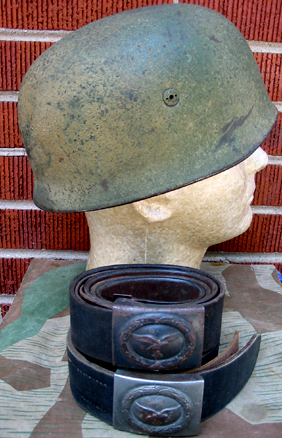 Above, a side view of the FJ stahlhelm liberated by Joe Pangerl, showing the liberally-applied sawdust under the camo paint.
Also pictured two Luftwaffe EM belts with blue and grey steel buckles, liberated by other 101st troopers from German paras.
Above, a side view of the FJ stahlhelm liberated by Joe Pangerl, showing the liberally-applied sawdust under the camo paint.
Also pictured two Luftwaffe EM belts with blue and grey steel buckles, liberated by other 101st troopers from German paras.
This helmet was finally added to the webmaster's collection in February of 2005, after nearly 15 years of coveting it, on six visits to Joe's home. This makes three FJ pots in my collection, all with the Normandy camo paint scheme and all with 101st Airborne vet provenance.
German Paratroop Gloves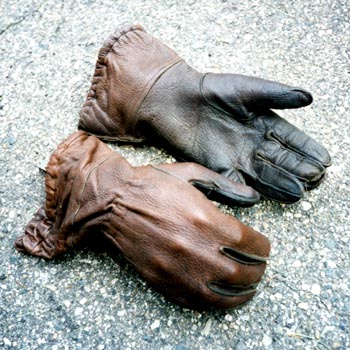 Harold Allen of HQ/1 501 missed the Normandy drop, due to a severe injury sustained on a pre D-Day practice jump in England. However, one of his buddies brought him back this souvenir, courtesy of the 1st Bn, 6th Para Regiment. These are the unlined, shorter version of the famous
Fallschirmjager gloves.
Harold Allen of HQ/1 501 missed the Normandy drop, due to a severe injury sustained on a pre D-Day practice jump in England. However, one of his buddies brought him back this souvenir, courtesy of the 1st Bn, 6th Para Regiment. These are the unlined, shorter version of the famous
Fallschirmjager gloves.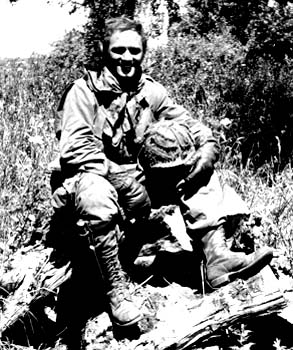 In the photo above, Tom Beszouska of F/502 can be seen wearing German paratrooper gloves in Normandy. photo c/o Ed Sapinsky
In the photo above, Tom Beszouska of F/502 can be seen wearing German paratrooper gloves in Normandy. photo c/o Ed Sapinsky
German Airforce Helmet Liberated in Normandy
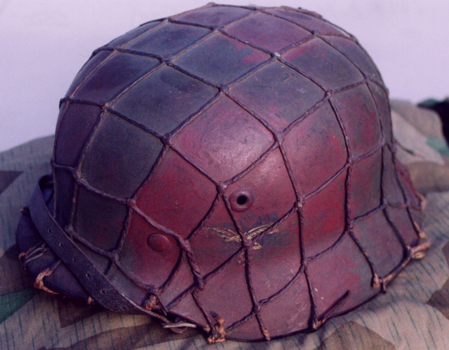 This M40 camo helmet for wear by Luftwaffe ground troops, was picked-up 'somewhere in Normandy' by Louis Frey of 2/501. It features an original twine net, which, curiously was in place when the camo paint was applied, causing the net to adhere to the helmet in most places. This precluded the attachment of any foliage under the net. Part of the flying eagle decal was painted around and is still visible on the left side. This may have been used by Luftwaffe flak troops, or even by a FJ trooper. Another favorite piece from the webmaster's collection.
This M40 camo helmet for wear by Luftwaffe ground troops, was picked-up 'somewhere in Normandy' by Louis Frey of 2/501. It features an original twine net, which, curiously was in place when the camo paint was applied, causing the net to adhere to the helmet in most places. This precluded the attachment of any foliage under the net. Part of the flying eagle decal was painted around and is still visible on the left side. This may have been used by Luftwaffe flak troops, or even by a FJ trooper. Another favorite piece from the webmaster's collection.
Mark Bando's Website
Don Zahn's Souvenir of Carentan
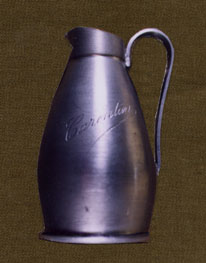 Pfc Don Zahn of H/506th was in a column of men, moving along a street into Carentan on 12 June, 1944. Periodic firing up ahead would cause the column to pause, as the men crouched low below a line of store windows, most of which were broken from the nearby concussion of artillery shells. While crouched below one of those store windows, Zahn looked up and spied the pewter cream pitcher depicted above, through a broken spot in the plate glass. He reached in and looted a great souvenir, with the word 'Carentan' engraved across the side. This item was added to the webmaster's collection in 2004.
Pfc Don Zahn of H/506th was in a column of men, moving along a street into Carentan on 12 June, 1944. Periodic firing up ahead would cause the column to pause, as the men crouched low below a line of store windows, most of which were broken from the nearby concussion of artillery shells. While crouched below one of those store windows, Zahn looked up and spied the pewter cream pitcher depicted above, through a broken spot in the plate glass. He reached in and looted a great souvenir, with the word 'Carentan' engraved across the side. This item was added to the webmaster's collection in 2004.
Counterattack on Carentan-13 June, 1944
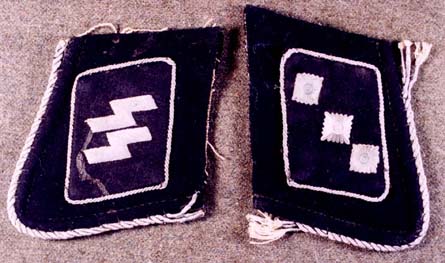 The 17th SS Panzer Grenadier Division tried to retake Carentan, France on 13 June,
1944. This division was new to combat, and it drove up to the Invasionsfront from the vicinity of Thouars, France. The
division's tank and antitank battalions were equipped mostly with Sturmgeschutze IIIs and IVs-(Self-Propelled guns, mounted
on Mk III and MKIV tank chassis, without turrets).
The 17th SS Panzer Grenadier Division tried to retake Carentan, France on 13 June,
1944. This division was new to combat, and it drove up to the Invasionsfront from the vicinity of Thouars, France. The
division's tank and antitank battalions were equipped mostly with Sturmgeschutze IIIs and IVs-(Self-Propelled guns, mounted
on Mk III and MKIV tank chassis, without turrets).
Normally, such crews wore a field grey wraparound tunic, but some
members of this division wore the black, panzer style tunic.
During the fighting on 13 June, a member of the 501 PIR saw
the owner of these tabs get blown from his AFV. The Waffen SS 2d lieutenant was killed somewhere SW of Carentan, France.
A unknown 501st trooper retrieved these tabs, for unit identification purposes, cutting-off the entire corner of two lapels,
and bringing them to Lt. Werner Meier of IPW Team #9, 501st PIR. When the webmaster obtained these tabs from Werner Meier
in 1989, Meier pointed-out a trickle of dried blood running down across the lightning flash runes and said "Be careful how
you handle that-it's dried blood!"
-courtesy Werner Meier
Subsequent investigation has revealed that the probable owner of these tabs was Untersturmfuhrer (W-SS 2d Lt.) Siegfried
Held, of 3rd kompanie, 17th SS Panzerjager Bn. (tank hunting Bn). That unit was equipped with 'Marders', (S.P. 75mm
guns, mounted on a Czech tank chassis.)
 Lt. Held is buried at the German military cemetery at Orglandes, France, NW of St Mere Eglise.
The photo above was made at Orglandes in May of 2008.
Lt. Held is buried at the German military cemetery at Orglandes, France, NW of St Mere Eglise.
The photo above was made at Orglandes in May of 2008.
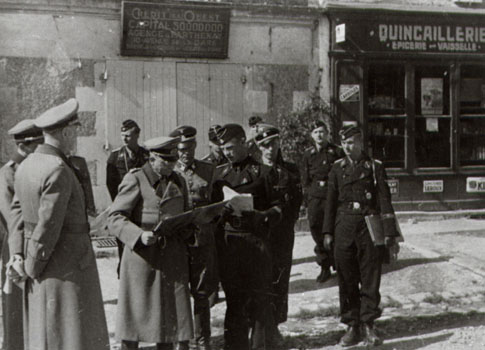 Turned-in to Lt. Meier around the same time as the collar corners above, was an undeveloped roll of W-SS film. The photo above (original is baseball card-sized), appears in my 'Vanguard' book. It shows 17th SS Panzer officers in Parthenay, France, enroute to the Invasionsfront, conferring with Generals from the Waffen SS and German Army. Two 'Untersturmfuhrer' (2d lieutenants) are visible in the photo, one of which could be Ustuf HELD. However, it's more likely that Lt. Held took the photo.
Turned-in to Lt. Meier around the same time as the collar corners above, was an undeveloped roll of W-SS film. The photo above (original is baseball card-sized), appears in my 'Vanguard' book. It shows 17th SS Panzer officers in Parthenay, France, enroute to the Invasionsfront, conferring with Generals from the Waffen SS and German Army. Two 'Untersturmfuhrer' (2d lieutenants) are visible in the photo, one of which could be Ustuf HELD. However, it's more likely that Lt. Held took the photo.
c/o Bill Canfield 501st S-2
 A 17th SS divisonal cuffband, removed from a battlefield casualty at Carentan, by Sgt Ed Benecke, A/377th PFAB
A 17th SS divisonal cuffband, removed from a battlefield casualty at Carentan, by Sgt Ed Benecke, A/377th PFAB
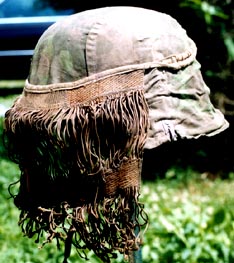 This Waffen SS sniper's helmet
belonged to a member of the 17th SS Panzer Grenadier Division, who was killed east of Carentan in June, 1944. It features a camo helmet cover with metal clips, a string face mask, and inside, a beautiful example of a raw-edged, single decal SS helmet. All hardcore collectors know how rare this item is, and doubly so with the string mask.
This Waffen SS sniper's helmet
belonged to a member of the 17th SS Panzer Grenadier Division, who was killed east of Carentan in June, 1944. It features a camo helmet cover with metal clips, a string face mask, and inside, a beautiful example of a raw-edged, single decal SS helmet. All hardcore collectors know how rare this item is, and doubly so with the string mask.
A Sgt in the 321st GFA Bn liberated this prize, and it is in the collection of GJD, a frequent contributor to our Forum. He is compiling a unit history of the 321st which will far surpass the info given in 'Mission Accomplished.' courtesy GJD collection
What Lies Beneath
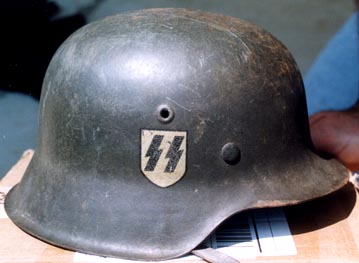 This is the helmet which hides under the camo cover and string mask shown above. courtesy GJD
This is the helmet which hides under the camo cover and string mask shown above. courtesy GJD
Non Regulation
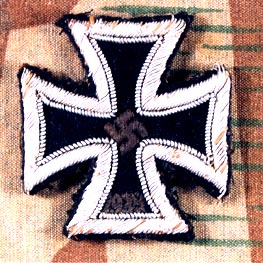 Although German regulations prohibited wear of a cloth version of the EK1 (Eisernes Kreuz ersten klasse, or Iron Cross 1st class), some individuals wore them regardless. This specimen, liberated by Lt
Joseph Pangerl of 502 IPW Team #1, was removed from a German uniform.
Although German regulations prohibited wear of a cloth version of the EK1 (Eisernes Kreuz ersten klasse, or Iron Cross 1st class), some individuals wore them regardless. This specimen, liberated by Lt
Joseph Pangerl of 502 IPW Team #1, was removed from a German uniform.
HISTORICAL ARTIFACT FROM HOLDY, FRANCEAround 2005, Dutch history buff John DeNeef (John502 on the TT forum) went digging near the site of the former Holdy gun battery. Near the large tree at the front right end of the battery position, he discovered and dug-up a German black wound badge.
That same year, a WWII German veteran named 'Horn', who had been captured there on D-day, was visiting the location. He spoke with John and told him that only two members of his unit (3rd Battery, 191st Artillery Regt, 91st Inf Div) were veterans of previous fighting and already decorated with the wound badge at the time of the Invasion.
Those men were both Obergefreiters (2 stripe corporals) named Jacobs and Becker.
So this badge likely belonged to one of them.
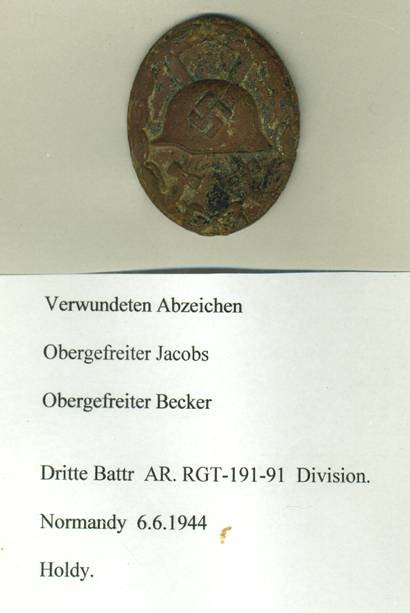 John framed the badge with this info as shown above. To further add to the history, testimony from Richard Brinkley (HQ/1 506th) which appears in my 'Avenging Eagles' book, indicates that a US para sgt armed with a TSMG was hanging dead in the large tree near which the badge was found. Brinkley had hurdled over this hedgerow and killed a German who was walking along the opposite side, clicking a captured cricket.
John framed the badge with this info as shown above. To further add to the history, testimony from Richard Brinkley (HQ/1 506th) which appears in my 'Avenging Eagles' book, indicates that a US para sgt armed with a TSMG was hanging dead in the large tree near which the badge was found. Brinkley had hurdled over this hedgerow and killed a German who was walking along the opposite side, clicking a captured cricket.
That German was either Cpl Jacobs or Cpl Becker.
To further add to the history, Doc Lage's photo showing himself smiling at the camera near his aid station on D-day has two German PW's standing in the background. The photo in question appears in three of my books, including the latest, on page 64.
The prisoner at left has no headgear on, the one at right wearing an M43 forage cap was identified by German veteran 'Horn', as himself.
 OK., here's the end to my story about the wound badge of Holdy. At the Bastogne Seminary during Euro TT #1,on 30 September, 2007, John D. presented the framed badge as a present to the webmaster-an amazing and appreciated act of generosity.
OK., here's the end to my story about the wound badge of Holdy. At the Bastogne Seminary during Euro TT #1,on 30 September, 2007, John D. presented the framed badge as a present to the webmaster-an amazing and appreciated act of generosity.
So now I'm sharing this with all of you.
German Backpack M1939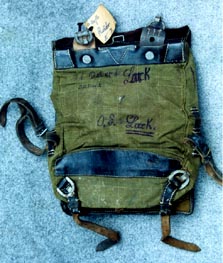 These German backpacks were ubiquitous with the troops stationed in Normandy, and many were retained by 101st men as souvenirs. The flap on the front side has brown fur, variously described in references as cowhide or pony fur. This specimen was liberated by LTC Ben Weisberg, C.O. of the 377th PFA Bn., and bears two different names, suggesting a change of owners. Obergefreiter (senior corporal)Rader, the latest owner's printed cardboard nametag, can be seen at upper left.c/o Ruth Weisberg
These German backpacks were ubiquitous with the troops stationed in Normandy, and many were retained by 101st men as souvenirs. The flap on the front side has brown fur, variously described in references as cowhide or pony fur. This specimen was liberated by LTC Ben Weisberg, C.O. of the 377th PFA Bn., and bears two different names, suggesting a change of owners. Obergefreiter (senior corporal)Rader, the latest owner's printed cardboard nametag, can be seen at upper left.c/o Ruth Weisberg
German Medic's Backpack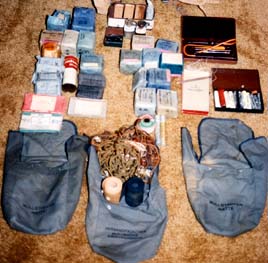 On D-Day, 2/501 medic Wayne Walton found himself at a small farmhouse on Drop Zone 'D'. In front of the house, two water-flooded ditches intersected at right angles. Wayne began giving first aid to injured American parachutists, turning the small building into a field expedient aid station. Later in the morning, a group of German parachutists, including a German medic, moved-in and took over the aid station. One of the Germans snapped photos of the American medics and wounded, posing with their new captors.
On D-Day, 2/501 medic Wayne Walton found himself at a small farmhouse on Drop Zone 'D'. In front of the house, two water-flooded ditches intersected at right angles. Wayne began giving first aid to injured American parachutists, turning the small building into a field expedient aid station. Later in the morning, a group of German parachutists, including a German medic, moved-in and took over the aid station. One of the Germans snapped photos of the American medics and wounded, posing with their new captors.
A few hours later, an attack brought the aid station under U.S. control once again. The German who had taken the photos was killed, and one of the marauding group which liberated the aid station took his camera. All weapons were tossed into the flooded ditches in front of the farmhouse. 501st medic Robert Schill was in the group which liberated the aid station, then continued on.
A German medic who went into captivity at this spot was forced to leave his cowhide flapped backpack behind. The bag has a red cross on a white leather circle sewn to the flap. The contents are shown above, to include salves, burn ointment, bandages, tape, a tubes and needles setup for transfusing blood, and numerous (now-empty) morphine syrettes. Wayne mailed the bag and contents home and it is now in the webmaster's collection. There are 3 smaller cloth bags inside the larger one, and one contains lengths of suspension line from German
parachutes, to be used as torniquets.
The Germans sorely needed any and all missing medical supplies in 1944. Medic Johnny Gibson of 3/506th was captured on D-Day and used as an aidman by the Germans until after the Mortain counteroffensive. He says that in the summer of 1944, the German medics were forced to remove gauze bandages from their dead, boil them in hot water, and re use them, due to shortages. Morphine was also in very short supply and most
German wounded had to get by with Mercurochrome and used bandages.
Souvenir Sleeve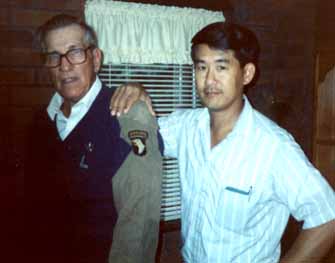 Demolitionist Jack Womer was among the 506th strays who wound-up with Colonel Johnson's 501 group on D-Day. When emerging from the bullrushes at Peneme on D-Day afternoon, Jack crawled onto a road, just as an 8cm German mortar shell exploded on the road. The blast went over Jack, but blackened the left sleeve of his gas impregnated, reinforced M42 jump jacket. Later, Jack discarded his worn-out jacket but kept the sleeve for a souvenir. Years of handling have greatly diminished the powder stains. The divisional eagle patch and elbow reinforcement are still in place. Jack had trained with the 29th Infantry Division Rangers prior to D-Day, and transfered to parachute duty only weeks before the Invasion. The
photo with the webmaster was made in 1993.
Demolitionist Jack Womer was among the 506th strays who wound-up with Colonel Johnson's 501 group on D-Day. When emerging from the bullrushes at Peneme on D-Day afternoon, Jack crawled onto a road, just as an 8cm German mortar shell exploded on the road. The blast went over Jack, but blackened the left sleeve of his gas impregnated, reinforced M42 jump jacket. Later, Jack discarded his worn-out jacket but kept the sleeve for a souvenir. Years of handling have greatly diminished the powder stains. The divisional eagle patch and elbow reinforcement are still in place. Jack had trained with the 29th Infantry Division Rangers prior to D-Day, and transfered to parachute duty only weeks before the Invasion. The
photo with the webmaster was made in 1993.
"They must have looked through the open gates of Hell"
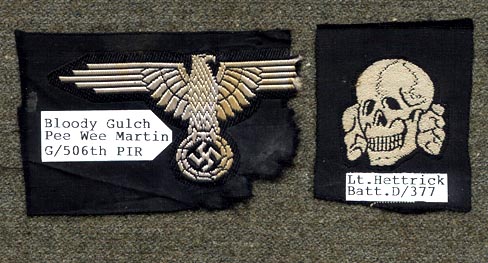 Regarding the 2 cloth insignia pictured above, the one at left would be considered 'trashed' by the average militaria
collector and it wouldn't even make it into a Ryker mount at a show. The insignia at right has been so widely reproduced
that many collectors would turn their nose up at this "obvious Repro", and walk right past it. But with the provenance
behind these pieces, they take-on a much wider significance.
Regarding the 2 cloth insignia pictured above, the one at left would be considered 'trashed' by the average militaria
collector and it wouldn't even make it into a Ryker mount at a show. The insignia at right has been so widely reproduced
that many collectors would turn their nose up at this "obvious Repro", and walk right past it. But with the provenance
behind these pieces, they take-on a much wider significance.
After the battle of Bloody Gulch on 13 June, 1944, Jim Martin of G/506th found the SS sleeve eagle at left, blowing along
the ground southwest of Carentan. It had never been sewn-on, and was evidently in the pocket of a 17th SS man when he was
torn to bits by an explosion. The ragged edge with powder residue and blood stains tells the story.
The SS cap skull
at right was also never sewn on. Lt Don Hettrick found it tucked inside the pages of an SS Soldbuch in the pocket of a dead
SS forward artillery observer at Champs, Belgium at the end of 1944. Hettrick had chased the SS man through 2 rows of trees
the day before, by artfully calling-in 75mm howitzer rounds on him as he ran through a row of pine trees. The SS man
escaped, but had been hit in the abdomen by shrapnel and left a trail of blood.
The next day, Lt Hettrick went into
a Belgian home in that vicinity and walked down into the root cellar (basement), which had a dirt floor. He chased away a
group of pigs, which were having a feeding frenzy. The gut-shot SS man had laid on that dirt floor, opened the front of his
tunic and trousers, then died. The pigs, attracted to the blood, had eaten his entrails, from the crotch to the ribcage. Lt
Hettrick removed the dead SS man's Soldbuch, rank insignia and decorations, which he later loaned to a collector. That
collection was destroyed in a house fire, but Don kept the skull insignia until recently, when it was added to the webmaster's
collection. The Waffen SS was a ruthless organization, but I hope the 2 victims described above died without prolonged
suffering. Still, it is possible that like the 2 dead Germans described by Don Burgett on page 122 of 'Currahee', they might
have "looked through the open gates of hell."




























































